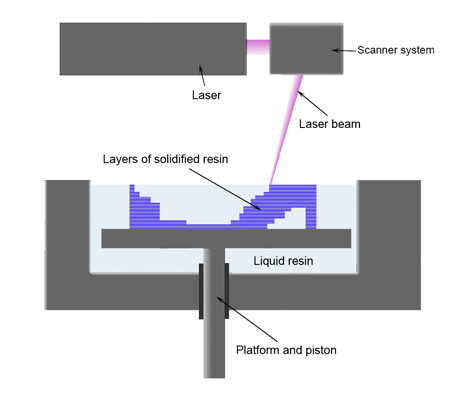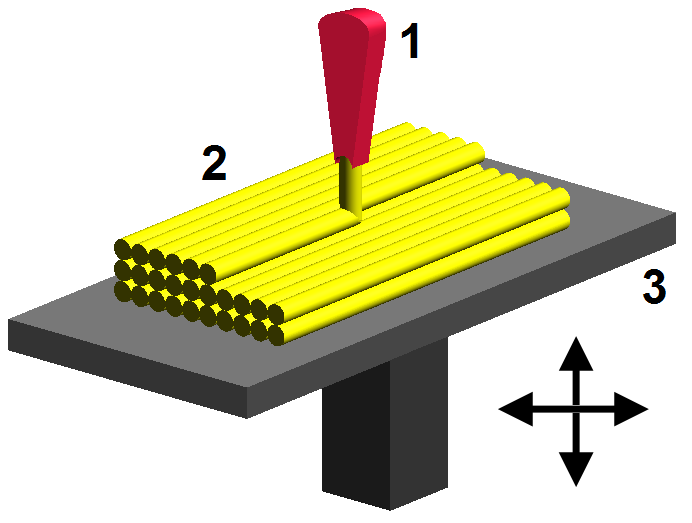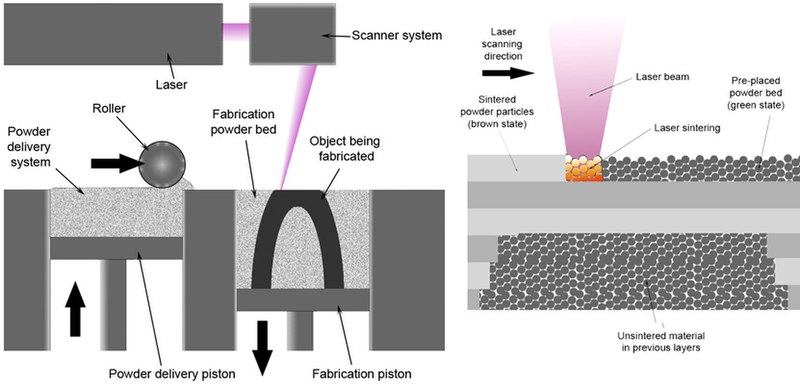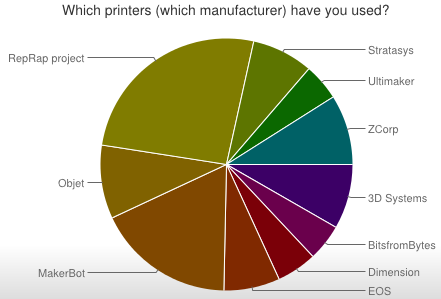Early History:
'3D printing' as it is known today actually spans several similar manufacturing methods that were a natural evolution from CNC machine tools developed in the first half of the 20th century CE.
| A manual wood lathe. |
 |
| A CNC lathe. |
 |
| Stereolithography (photo-polymer resin) 3D printing. |
 |
| Fused Deposition Modelling (thermoplastic extrusion) 3D printing |
 |
| Selective Laser Sintering (one type of powder printing) |
These methods allow a great variety of materials to be used, and also eliminate the problem of printing sections that overhang the print-bed when using FDM in Earth's gravitational field, which can otherwise sag if not solidified rapidly enough, although that particular problem has more recently been solved within FDM by using a second extruder to lay out a soluble support material such as PVA, which can then be easily washed away from the printed object.
Enter the Replicators:
In 2005, the RepRap project was founded by Dr Adrian Bowyer and some of his students at the University of Bath. Its stated aim was to produce a "Replicating, Rapid-prototyping" machine, i.e. a 3D printer that could produce some or all of the key components needed to assemble an exact (or better) copy of itself. With a keen interest in biomimetic systems (ones that mimic natural biology), Adrian's hope was that by allowing these machines to self-replicate, given a user with a supply of basic industrial materials and fittings, they might replicate exponentially and hence create an exponentially increasing production capacity, while given some human creativity, they might also evolve into more advanced forms. Both of these hopes have turned out to be true since the project began.
Within two years the first full design was complete, named after Charles Darwin, one of the founding theorists on biological evolution, a trend which continued through the project. It was based upon Fused Deposition Modelling, but since Stratasys had trademarked that term, the project coined the general term "Fused Filament Fabrication" for their production method. Another year passed and the first 'child' of this machine, fully constructed from parts printed on the first 'Darwin' along with standard fasteners, started printing a 'grandchild' part in May 2008. By September it was estimated that there were at least 100 copies of Darwin 'in the wild'.
In November, one of the RepRap contributors, Zach Smith, launched a website called Thingiverse, which allows people to upload Free-and-Open-Source digital designs for others to print. At the start of 2009 he then co-founded a startup known as MakerBot Industries with his friends Adam Mayer and Bre Pettis. Their company would go on to take a large share of the US market for hobbyist 3D printers by using cheap laser-cut parts in their kits, combined with clever marketing, and received a warm reception from the 'maker' community for their supporting website Thingiverse, though they suffered some controversy in later years when they took $10-million in venture capital investment from The Foundry Group, filed a patent on one of their designs, and were recently criticised for releasing a closed-source/proprietary printer based upon past open-source innovations, which was even criticised by Zach Smith who has since left the company.
By October '09, the second full design for a RepRap was released, named after Gregor Mendel, and its stark improvements in design were detailed here by Edward Sells:
In the next two years there were several more variations made upon this design, including a miniaturised version named after Thomas Huxley, a greatly simplified and low-cost version designed by Josef Prusa, plus many small modifications and one-off 'RepStraps' (coined from 'bootstrapping') that adapted those designs to locally available materials.
By September 2011, the quality of a RepRap Prusa Mendel had surpassed that of some Stratasys systems:
Come forward to 2013, and there are dozens if not hundreds of full designs for DIY 3D Printers listed on the RepRap Project Wiki, Github (including Free and Open Source Software on which to run a printer), and on Thingiverse, while several alternative ways to host free 3D-design files have been springing up, such as the 'Physibles' torrent category on The Pirate Bay, graphical page templates for MediaGoblin and Github, and easy-to-use sites like CubeHero and Fizzybles.
Some notable designs include the Printrbot designed by Brook Drumm, who intended for it to be so simple and low-cost as to enable putting one 3D printer in every school, and easy enough to construct that any interested students could build their own from parts printed on a school machine. A designer calling himself Whosawhatsis has been redesigning this to be more robust and naming its successor after Alfred Wallace.
The MendelMax design is known for being one of the most rigid RepRaps, using aluminium extrusions for its frame, as are used in some commercial CNC machines, and building upon this solid design, the Colorado-based company Aleph Objects released a printer that was the first hardware product to receive the 'Respects Your Freedom' certification from the Free Software Foundation.
The Current State of 3D Printing:
In May 2012, the first major statistical survey of the 3D Printing community showed up many interesting points, including this distribution of printer types, showing that for sheer volume and quality for a given price, nothing could beat RepRaps, which had only been around for a quarter of the time of the professional rapid-prototyping companies, and that PolyLactic Acid, a biodegradable polymer made from plant starches, is now the most-used 3D printing material.
 |
| RepRap For The Win |
It should be noted that 3D Systems had spent much of the previous two years buying up 24 small 3D printing companies in order to become the largest 3D printing company in the international market, but that only lasted until Stratasys and Objet merged to form an even larger competitor.
More recently, Joseph Flaherty of Wired reported on 10 existing patents that may stymie new business startups in the 3D-printing industry.
Nevertheless, various extremely high-tech and low-environmental-impact innovations based upon 3D Printing have been brought out in the last couple of years, which are set to evolve several industrial sectors and ways that we solve problems.
For example, a team in Glasgow University have been developing 3D-printed chemical reaction vessels that allow highly complex drugs and other organic molecules to be produced from basic ingredients, by customising the paths through which they interact, and so control the duration and nature of those chemical reactions, to bring about a maximum amount of a desired product.
'Bio-Printers' such as those produced by Organovo are getting close to being able to produce artificial yet biological and fully-functional human transplant organs, tailored to the needs of the recipient. Last year they were already printing lengths of blood-vessels that could be used for the likes of cardiac-bypass operations. Not only could this ease the strain on our medical system's use of organ donations for life-saving or reconstructive surgery, but could also reduce the risks involved with it. Some DIY versions are already popping up.
Contour Crafting, a type of 3D printing similar to FDM/FFF but using ceramic materials such as clays or concretes, has been suggested as a method for producing dwellings with high material efficiency both on Earth and on expeditions to Mars or our Moon. Open source versions of similar technology have shown to be capable of printing some very intricate structures in clays:
The capabilities of commercial CNC machines and 3D printers are reaching amazing levels, with Objet's new '1000' printer being capable of creating objects 1 metre long and printed out of 14 different materials. Meanwhile, initial results are being released on an open source powder-printer prototype and an open source 3D scanner may make it easier than ever to precisely reproduce museum items without damaging them.
What this could mean for the future:
There has been much debate lately about the significance of 3D Printing and its possible effects upon human industry. While it presents a radical expansion of production capabilities, critics have been quick to point out that 3D Printers may not find a 'mass market' (i.e. to see one in every wealthy home, as with lesser robots such as inkjet printers, washing machines or microwave ovens), because an average working person doesn't know how to use CAD software or have enough experience with mechanical design to create their own functional novel items, or because the price of small plastic parts will always be lower for mass moulded parts, and the market for novelty items is very small. However, these critiques turn out to be awkwardly myopic once you realise they are confined to a belief that a capitalist market system can be sustained indefinitely.
Many people have been looking at the available data on our global resource stocks and industrial output, and have come to a conclusion with extremely little doubt, that not only is the current paradigm of 'economic growth' impossible to continue in light of our current fossil fuels and other resource stocks, but even if we were to stop increasing our consumption right now, our current use of natural resources would crash into a wall of disappearing non-renewable resources (or slow-renewing ones like fossil fuels, which took millions of years to form, and little over a hundred years for us to burn halfway through them), and those high-tech gadgets that western societies habitually build to shoddy standards and then throw away, would be available to even fewer people.
It is imperative now that we not only use renewable energy and recyclable resources, but we must pay more attention than ever to the first of those three R's often used as a municipal recycling service slogan - Reduce, Reuse, Recycle. We must first reduce our cyclical consumption of natural resources to almost half of their current levels, and begin completely phase-out any linear use of non-renewable or non-recyclable materials. As Dr David MacKay so astutely pointed out:
"Have no illusions. To achieve our goal of getting off fossil fuels, these reductions in demand and increases in supply must be big. Don’t be distracted by the myth that “every little helps.” If everyone does a little, we’ll achieve only a little. We must do a lot. What’s required are big changes in demand and in supply."
The same goes for resources more tangible than our energy supply. It doesn't matter if you re-used a plastic bag from a supermarket, those things are difficult to recycle and tend to result in an inferior material that cannot be used for its original purpose (i.e. they are downcycled, not recycled). I have said for several years that if regulating a market via 'representative democracy' were ever feasible, we would have long ago seen a blanket ban on non-biodegradable plastic films for food packaging, and on any use of those plastics where a recycling system was not in place. However, if a 'free market' could really bring about rational use of resources on its own, then we wouldn't have to tell these suppliers not to do such irrational things in the first place. Yet we do have to, and mindless mass consumerism for the sake of cultural or advertising whims, as Edward Bernays encouraged so well, has to stop if we want to survive as a species.
 |
| "The Earth is the only world known, so far, to harbor life. There is nowhere else, at least in the near future, to which our species could migrate. Visit, yes. Settle, not yet. Like it or not, for the moment, the Earth is where we make our stand. It has been said that astronomy is a humbling and character-building experience. There is perhaps no better demonstration of the folly of human conceits than this distant image of our tiny world. To me, it underscores our responsibility to deal more kindly with one another and to preserve and cherish the pale blue dot, the only home we've ever known." - Carl Sagan, Pale Blue Dot: A Vision of the Human Future in Space, 1997 reprint, pp. xv–xvi |
Luckily for us, there are far better methods of organising consumption so as to increase our material efficiency such that we meet people's recurring needs not with half as many resources as we do today, but with more like a tenth of that input. One model to meet this need, which has been gaining popularity recently, is known as 'Collaborative Consumption'. Simply put, this involves a community, or individuals within one, acquiring tools that people may need to use infrequently, such as vacuum cleaners, high-resolution cameras, performance equipment, et cetera, and borrowing them from each other while sharing the cost of maintaining them.
There is also a type of institution that has done this successfully in the background for centuries, contributing enormous amount of value to human culture and technology - we call these institutions Public Libraries. In western nations today, they provide a lot more than just books, yet there is still so much that they are lacking.
Every parking lot packed with cars awaiting their registered keepers, every white-collar house stuffed with dusty sports equipment that youth clubs could use, and every new-year's dumpster filled with discarded plastic toys from a previous year's Consumptionmass, is a testament to the possible abundance of human productivity, squandered by a system based upon fear and status.
Yet islands of trust are appearing within that ocean of fearing one's neighbour, even if these examples do begin with locks and keys on shared items, just as public libraries within this monetary system regularly place RFID tags in books, and corresponding alarms at their doors, to work around the neuroses generated within that marketplace. Examples include the US car-sharing company Zipcar who as of last month were sharing less than 10,000 vehicles between over 777,000 people, and the Vélo'v service in Lyon, France, where from the years 2005-07, 16,000 journeys per day were completed between 343 stations, with around 4,000 bikes, with the service reporting having over 52,000 subscribers at that time.
These systems form an important transitionary step in a trend towards a situation that has been advocated by groups such as The Zeitgeist Movement, termed 'Access-Abundance'. In such a situation, communities would produce a small number of such short-used tools compared to the number of users, yet more than would be needed at any one moment, to the highest material standards possible, in order so make huge long-term savings in time, space, energy and raw materials. Such low-scale and localised consumption is ideal for the application of 3D printing, which would be able to not only create an infinite variety of ergonomic customisation for local users' needs, but also create replacement parts on the same day that they are needed, instead of keeping warehouses full of spares and waiting a week for them to be delivered. That goes even without mentioning that repair is better, and that the collaboration that comes with the use of a local hackerspace or tool library yields its own fruits in sparking people's creativity.
In summary, a wholesale evolution in production can be provided by 3D Printing, it can drive costs of production towards zero, and not only is it completely possible, it's completely necessary.

Hi buddies, it is great written piece entirely defined, continue the good work constantly.Read more
ReplyDelete